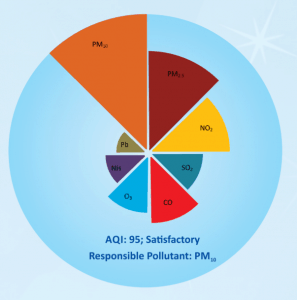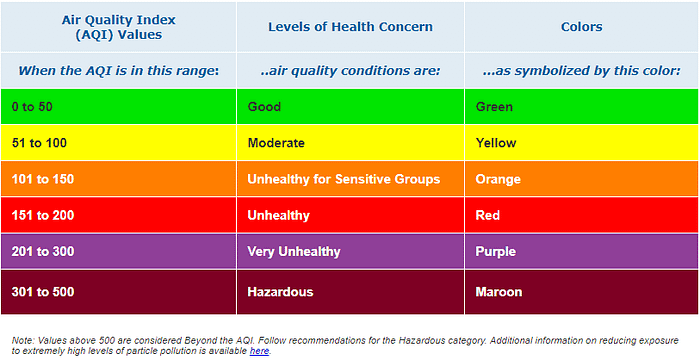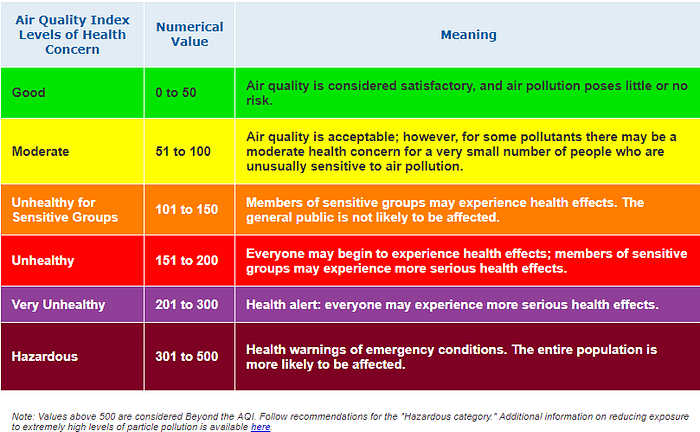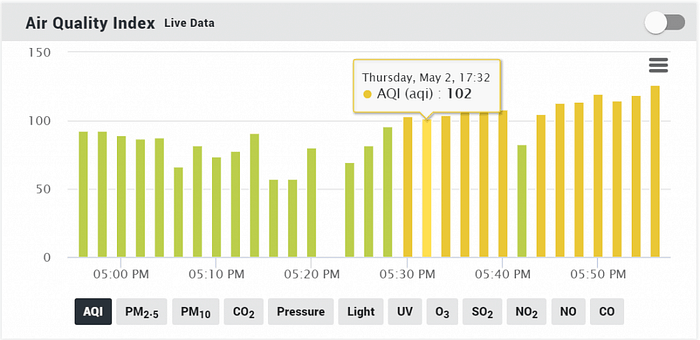Clean air is the basic amenity when it comes to healthy living for mankind. Today poor air quality is one of the main reasons for several acute health diseases. It is essential to know the air quality of your locality, city, and nation to assess its impact on your health.
Air quality is an outcome of the complex interaction of several factors involving the chemical reactions, meteorological parameters, and emissions from natural and anthropogenic sources.
Air pollution levels are higher near specific pollution sources such as traffic junctions, industries, mines, etc. Special measures to reduce pollution are necessary for the welfare of the populations living nearby.

What is AQI?
MoEFCC describes AQI or Air Quality Index as ‘One Number- One Colour-One Description’ for the layman to judge the air quality within his vicinity.
AQI is an index used to report daily air quality. It tells you how unhealthy the ambient air is and how polluted it can become in the near future. It also educates you on what associated health effects might be of concern. It primarily focuses on the adverse health effects you may experience within a few hours or days after breathing unhealthy air.
Air Quality Index is a scale designed to communicate the current air quality status to the people in readily comprehensible terms. It converts the complex air quality data of different pollutants/contaminants into a numerical value (index value), terminology and colour.
The main objective of the AQI is to inform and caution the public about the risk of exposure to daily pollution levels. With an increase in AQI, a large number of population is exposed to severe health conditions.
Did you know “An average adult inhales around 11,000 litres of air per day.”
How to calculate AQI
Computing the AQI requires the concentration of a pollutant over a specific period provided by an air monitoring system. The function used to convert air pollutant concentration to AQI varies by pollutant and varies from country to country. The major pollutants are divided into ranges, and each range is assigned a descriptor and a colour code.
Each AQI range has a Standardized public health advisory associated with it. Primarily two steps are involved in developing an Air Quality Index:
Step 1: Creating sub-indices for each pollutant
Step 2: Aggregating (breakpoints) these sub-indices
Segmented linear functions are used to relate each pollutant’s concentration for relating the actual air pollution concentrations (of each pollutant) to a normalized number (i.e., sub-index).
A pollutant’s index value is basically its concentration expressed in terms of percentage of an applicable standard. An index for any given pollutant is its concentration expressed as a percentage of the relevant standard. The maximum value of sub-indices of each pollutant is taken to represent the overall AQI of the location. Breakpoint concentrations are defined by the NAAQS and results of epidemiological studies and depend on indicating the risk of adverse health effects of specific pollutants. Therefore, these breakpoints for each pollutant can vary.
As per Indian AQI, primarily a health-related index is divided into six AQI categories, namely Good, Satisfactory, Moderately polluted, Poor, Very Poor, and Severe.


Each of the above AQI categories represents a different health concern level. EPA (Environmental Protection Agency) has assigned a specific color to each category to make it easier for people to understand the level of pollution in their communities. For example, the green color means that conditions are “good and unhealthy for sensitive groups,” while maroon color means that the environment is hazardous and emergency actions need to be taken.

Importance of AQI
The citizens play a crucial role in improving the air quality of a nation. The citizens should be well-informed about the local and global air pollution problems and the ways to mitigate them.
However, a broad overview of the high air pollution concentrations or even the frequency of the NAAQS exceedance is not sufficient for the citizens to assess the urban air quality. The general public needs information on the pollution levels and the associated potential health risks of air pollution presented in a simple, understandable format.
There are various continuous air monitoring systems installed in big cities showing the city’s environmental health in different numbers and colours. But the monitored data is in large volumes and does not give a clear picture to the decision-maker or to the common man who wants to know how good or bad the air is?
Thus, effective and obvious communication of air quality is important.
Along with indexing the air quality, AQI also provides advice on how one can improve the quality of the air one inhales. This index particularly considers the people sensitive towards air pollution and advises them ways to protect themselves from different health risks posed at various air quality levels.
It is very crucial for those who spend most of their time working or exercising outside as they are prone to higher exposure and may have difficulty breathing when air pollution levels are Severe.
AQI is all the more important in developing nations like India where the common man is not quite familiar with the technical terminologies and measuring units (like ppm /ppb / or µg/mg3 ). Hence the AQI simplifies the understanding of their air quality by decoding the quality in terms of unitless numbers and color, with each figure and color representing a different category of associated health risk.
Doctors can also use AQI in predicting when they identify an increase in cases with respiratory distress, as they decipher to be susceptible when the AQI is high.
How to interpret AQI?

– Air Quality Index (AQI) helps in explaining how to plan activities around air quality and help us live the healthiest lives possible. Hence, learning to read and interpret the AQI is the first step in engaging with our health and air quality.
– AQI assesses individual air pollutant level in the ambient air. Interpreting AQI may sound complicated, but when broken down it really is quite simple. AQI communicates the air quality in terms of number from 1 to 500. The higher the number, the greater the health risks associated with the air quality. When the level of air pollution is very high, the number will be reported above 300.
– Ideally, when the air quality is good, the AQI is low (0–50), and the color associated with it is green. As the air quality worsens, the number gets higher, and the color associated with it becomes a darker shade of red.
Oizom Terminal — A cloud-based data visualization and analytics platform derives the AQI as per the National standards. The parameter wise data from the Oizom Environmental Monitoring Equipments can be seen as below for ease of interpretation.

This snapshot depicts the AQI of a particular time, based on the appropriate colour-code and index value from the maximum value of sub-indices of each pollutant.
More info on Oizom Terminal: www.oizom.com/data-visualization
Your response to AQI
The AQI fluctuates during the whole day, making it easy for you to plan your day’s activities.
Poor air quality brings many health problems like cardiovascular disease and respiratory problems such as asthma, allergies, pneumonia, and bronchitis. On days when the AQI level is above 101 (yellow), you should take appropriate steps to limit your exposure.
Some precautionary measures/safety tips during the poor air quality days:
– Find out the air quality in your area before planning your day.
– Minimize your exposure by avoiding highly polluted areas like high-traffic, industrial areas, especially at peak pollution hours.
– Try exercising indoors on days when air quality is poor so that you can benefit from pollution-free air. Contribute to improving long-term air quality by reducing emissions as much as you can. Use public transportation or carpool with your family and friends whenever possible.
Others
It is proposed that for continuous air quality stations, AQI is reported in near real-time for as many parameters as possible. For manual stations, the daily AQI is reported with a lag of one week to ensure manual data are scrutinized and available for AQI.
References
- https://www3.epa.gov/airnow/aqi_brochure_02_14.pdf [USEPA : AQI: A Guide to Air Quality and Your Health]
- http://pib.nic.in/newsite/PrintRelease.aspx?relid=110654 [MoEFCC]
- http://safar.tropmet.res.in/AQI-47-12-Details
- http://www.indiaenvironmentportal.org.in/files/file/Air%20Quality%20Index.pdf (National Ambient Air Quality Standards, CPCB)
- https://www.tropmet.res.in/~lip/Publication/RR-pdf/RR-127.pdf
- https://intermountainhealthcare.org/blogs/topics/live-well/2015/02/know-the-air-quality-index-and-how-to-use-it/
- https://airnow.gov/index.cfm?action=aqibasics.aqi

Read more on Air Quality Monitoring at Oizom.